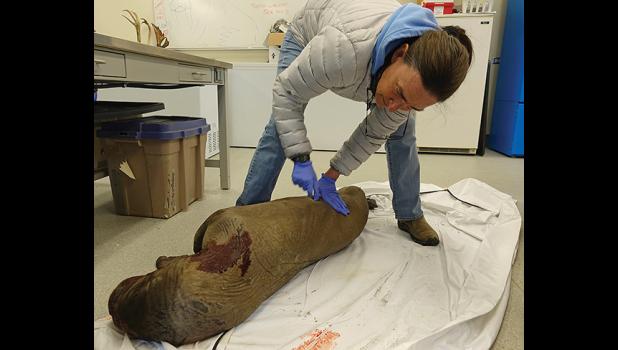Seal pups and walrus calves found stranded on regional beaches
In Nome and the region reports of seal pups and walrus calves hauled out on beaches are piling up at an unprecedented rate.
UAF Alaska Sea Grant agent Gay Sheffield reported that Nome residents alerted her of 12 marine mammals found on beaches this week. Those included nine live seal pups resting on shore as well as two dead walrus calves and one dead seal pup. Gambell reported eight dead young bearded seals found ashore. Of these, a 210-lb. subadult bearded seal found in Gambell and one of the walrus calves found in Nome were sent to the North Slope Borough Department of Wildlife Management for examinations to determine the health as well as the cause of death for both, Sheffield said.
"Given the unprecedented open water conditions throughout the Bering Strait region, it will be helpful to understanding the impacts to the marine ecosystem by reporting the unusual behaviors, injuries/death with the regional marine wildlife," said Sheffield. Signs will be put up to alert the public to not disturb the seals or walruses if found on the beach. Alaska Native hunters engaging in substinence activities are exempt.
A group of Shaktoolik school students saved a bearded seal pup that was found on the beach in Shaktoolik without it’s mother. The children observed the emaciated week-old seal for several days and protected the pup from curious people and pets. Their interest led the village to call the Alaska Sealife Center in Seward. After NOAA gave permission to transfer the seal it was transported to Seward, arriving on April 13. Now in quarantine, the young seal is gaining weight.
“When she came in on the 13th she weighed 22.9 kg,” said Chloe Rossman of the Sealife Center. That’s just over 50 pounds. “As of Tuesday she weighed 39.2 kg. She’s doing really good.”
Bearded seals gain weight rapidly after birth thanks to their mother’s rich milk. In the wild they gain three times their birth weight within a few weeks. “If you feed too much fat to a starving animal too quickly it can be harmful. We have to take her weight gain slow to make sure her body can process the nutrients,” said the center’s Wildlife Response Curator Jane Belovarac. The center has not had many bearded seal pups so they had to create a special formula for this one. The vets combined elements from walrus, harbor seal and fish gruel formulas.
The low weight meant the pup was having trouble regulating its body temperature, particularly when swimming. The staff would keep a close eye on her when she was in the water and pull her out before she got cold. As she builds up a layer of blubber the problem will become less critical.
The Sealife Center’s last bearded seal in distress was in 2002.
When the pup rescued last week grows to maturity she will not be released back to the sea. The pup is non-releasable due to the National Marine Fisheries Service policy established for the four species of Alaskan ice seals. Ribbon, bearded, spotted, and ringed seals are considered non-releasable in the state due to consideration of subsistence hunters.
“During our quarantine period animals have to be by themselves because we want to make sure that if that animal does have something that another animal could get that would negatively affect its health. We want to make sure that contamination doesn’t happen throughout the facility,” said Rossman. “So we have a strict quarantine zones within our wildlife response area.”
The quarantines last about a month. At the end of that period the pup will get a name. What happens to her later is determined by NOAA and the U.S. Department of Fish and Wildlife.
In June of 2017 a walrus calf crawled aboard the gold dredge AU Grabber just off Nome. The 120-pound calf was still there the next morning so the crew of the dredge called the Sealife Center’s hotline to alert them. Marine Mammal Stranding Responder Gay Sheffield then assisted the baby’s transfer to Seward. The calf was nursed back to health in Seward and because they have no space for an adult walrus, Aku, as the baby was named, was sent by the federal authorities to Marine World in Florida. A calf nearly the same age had been born there and the feds saw an opportunity for the two to grow up together. Aku is now a juvenile and getting bigger every day.
Due to receding sea ice, marine mammal strandings become more frequent. Just this week, several seal pups and a dead walrus calf were seen on beaches in the region.
When people come across any distressed marine wildlife or walrus in the Bering Strait region, they should contact: Kawerak Subsistence Program, Brandon Ahmasuk (443-4265); UAF Alaska Sea Grant, Gay Sheffield 434-1149; Eskimo Walrus Commission, or the NMFS Marine Mammal Stranding Hotline (877) 925-7773.

